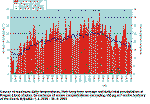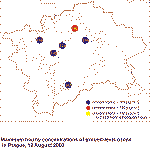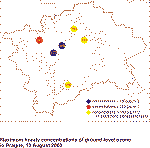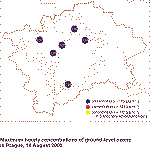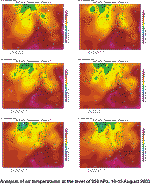|
|
AIR POLLUTION IN THE CZECH REPUBLIC IN 2003 Czech Hydrometeorological Institute - Air Quality Protection Division |
|
|
|
|
2.3. Evaluation of the smog regulation systems operation on the territory of the
Czech Republic in 2003
The winter months on the turn of the years 2002 and 2003 had, with regard to the temperatures and precipitation, significant fluctuations and generally mildly subnormal temperatures. The temperatures of February 2003 were slightly subnormal with maximum deviation ŌĆō3,0 ░C from the normal but in January and March the temperatures were slightly above normal. The precipitation in January 2003 was mildly to slightly above normal whereas the precipitation totals in February and in March 2003 were markedly below the normal and declined to 33 % and 38 % of the normal respectively. The January snow cover in the mountains was 60ŌĆō100 cm, in February and in March the mountain ridges had 30ŌĆō90 cm of snow. The winter period on the turn of the years 2003 and 2004 recorded temperatures slightly above normal, and the precipitation was around the normal. Markedly above normal was November 2003 with average monthly temperature 4.8 ░C. The total precipitation of November 2003 was markedly below normal; the measured value (22 mm) represented 45 % of the normal. The December 2003 precipitation was above normal. The January atmospheric circulation was characterized by almost the same occurrence frequency of cyclonic and anticyclonic situations, in February and in March the anticyclonic types prevailed distinctively. In November and December 2003 the anticyclonic character of the weather covered 61ŌĆō63 % of the two-month period. The assessment of the winter period 2002ŌĆō2003 was specific and influenced by the fact that the new legislative documents on air quality protection and operation of smog regulation systems came into force in the Czech Republic. The respective provisions of the Act No. 86/2002 Coll. (Clean Air Act) cancelled, among others, the Decree No. 41/1992 Coll. This Decree setting the operation of the smog regulation systems was replaced by the Decree No. 553/2002 Coll. This new legislative document substantially modified mainly the alert threshold limit values upon the exceedance of which the smog situations are issued, and the directory of stationary sources liable to the regulation set by the central regulation rules was changed. The central regulation rules will be applied only to the selected stationary sources in ├Üst├Ł nad Labem and Karlovy Vary Regions, the rules are out of force in the Ostrava Region. Alert threshold limits have been newly set for SO2, NO2 and ground-level ozone. Today there are no serious impacts of SO2 air pollution concentrations and in accordance to the previous assessment of long-term trends of the number of days with the issued signals within the Smog Regulation System it can be expected that no regulation of sources due to high SO2 concentrations will be issued. Similarly, the transition from the sum of nitrogen oxides to the assessment of NO2 will ensure, as prognosed by the earlier assessment of the Smog Warning and Regulation System, very low probability of fulfilling the conditions for the signals to be issued. Hourly averages of NO2 concentrations did not reach the level of the alert thresholds at the beginning of the year 2003. The highest NO2 concentrations occurred mostly at the end of February when the weather above the territory of the Czech Republic was influenced by the governing anticyclone with the centre above Scandinavia, later above eastern Europe. During the whole period inversions and weak air flows occurred and bad dispersion conditions prevailed. Similar meteorological situations which resulted in deteriorated air quality occurred also at the beginning of the second December decade when the territory of the Czech Republic was influenced by the anticyclone. Though the meteorological situations, during which unfavourable dispersion conditions necessary for the accumulation of pollutants close to the ground were recorded, represented potential danger with regard to the occurrence of the smog situation, no signals within the Smog Warning and Regulation System had to be issued during the monitored period as nowhere in the ├Üst├Ł nad Labem and Karlovy Vary regions the respective conditions for the signals to be issued were fulfilled. It is obvious that the decreasing trend of the number of signals issued continues and this favourable situation can be expected in the next years unless there is no in-mass return to solid fuels in local heating. Certain potential danger is represented mainly by traffic producing increased NO2 concentrations, mainly in larger cities. Nevertheless even there the NO2 alert threshold limit values were exceeded only sporadically and the episodes were not continuous. The alert threshold for SO2 was not exceeded at any station. In the next years it will be therefore necessary to focus on the ground-level ozone for which the signals are issued within the central regulation rules in the summer period. Ozone is a typical secondary pollutant, created in the atmosphere under the influence of solar radiation on nitrogen oxides and VOCs. Initial substances of the complex chemical reactions resulting in ground-level ozone creation, are called precursors. More than 50 % of ozone precursors are represented by air pollution from traffic. Optimum meteorological conditions for the creation of ground-level ozone, i. e. intensive solar radiation, high temperatures and calm weather or light wind, occur in anticyclonic situations in summer periods. From 1 April to 30 September 2003 the anticyclonic and cyclonic situations determining the character of the weather in the Czech Republic were represented by equal shares. The lowest number of anticyclonic situations, on 8 days in total, occurred in July. On the contrary, the highest number, on 25 days in total, occurred in August when the continuous series of only anticyclonic situations from 3 to 27 August with prevailing western anticyclonic-summer type was recorded. In May the station Prague-Libu┼Ī reported the highest maximum daily temperature 26.5 ░C, in July it was even 34.4 ░C and on 13 August the record temperature was measured (37.6 ░C). The value measured on 13 August in Klementinum (36.8 ░C) exceeded the temperature record from the year 1861 (34.8 ░C); in Kopisty the temperature reached 39.5 ░C. (Fig. 2.3.1) The analysis of meteorological situations shows that in the period between 1 April and 30 September 2003 the conditions for the creation of ground-level ozone were favourable. In the period from 12 June to 19 September 2003 the alert threshold limit value of 180 ╬╝g.m-3 was exceeded on 14 days in three subsequent hours at least at one station of the automated monitoring network on the territory of the Czech Republic. The above limit value was exceeded at more than 2 stations on 5 days. Due to the long-term character of anticyclonic situations between 3 and 27 August 2003 the limit value was exceeded on 6 days; on 13 August the exceedance occurred at 31 stations. The ozone concentrations at the stations in the Ostrava Region, in hot spots in Prague, Brno, Plze┼ł and in Teplice and Jesen├Łk remained below the limit value. The survey of ozone concentrations exceeding 180 ╬╝g.m-3 in three subsequent
hours is given in the following table.
The most significant episode of high ground-level ozone concentrations occurred between 12 and 14 August 2003. During the monitored period the anticyclone of 1020 hPa with the centre above southern Hungary moved across northern Italy to southern Spain and enabled the shift of the frontal zone from northern to central Europe. On the rear side of this anticyclone very warm air from south came at first to western, later also to central Europe. At the end of the period two subsequent cold fronts came from northwest to the territory of the Czech Republic and the air masses exchanged. On 12 August the whole territory of the Czech Republic had mainly somewhat cloudy weather, with non-measurable precipitation. Maximum temperatures reached 36 ░C in Bohemia, in Moravia 32 ░C. On the following day the weather was somewhat cloudy, temporarily cloudy, in late afternoon and night hours cloudy to overcast with showers and storms. The amount of precipitation ranged from non-measurable values to 11 mm; the higher totals were recorded in the north, the lower in the south. Maximum temperatures reached 36ŌĆō39.5 ░C. On 14 August the weather was somewhat cloudy to cloudy with abundant precipitation (in Bohemia up to 13 mm, in Moravia up to 17 mm). Maximum temperatures in Bohemia reached 33 ░C, in Moravia 36 ░C. On 12 August within the very warm air mass moving over the territory of the Czech Republic in the westŌĆōeast direction (Fig. 2.3.2) the maximum values of ground-level ozone exceeded 180 ╬╝g.m-3, at first only in the western part of Bohemia (Fig. 2.3.3, Fig. 2.3.4, Fig. 2.3.5), on 13 August 2003 almost on the whole territory of the Czech Republic except for the Ostrava Region, hot spots in Prague, and in Plze┼ł, Brno, Teplice and Jesen├Łk as well. Approximately on the half of the territory of Bohemia and in small areas in southeastern Moravia the maximum concentrations exceeded 200 ╬╝g.m-3 with the highest value of 235 ╬╝g.m-3 in Pardubice. (Fig. 2.3.6, Fig. 2.3.7, Fig. 2.3.8). On 14 August 2003, after the passage of two cold fronts across Bohemia and major part of Moravia the ozone concentrations declined to 140ŌĆō160 ╬╝g.m-3, the value of 180 ╬╝g.m-3 was exceeded only in southeastern Moravia and at Chur├Ī┼łov (Fig. 2.3.9, Fig. 2.3.10, Fig. 2.3.11). More significant episodes with ground-level ozone concentrations above 300 ╬╝g.m-3
occurred simultaneously in western Europe, mainly in France and Germany. Fig. 2.3.1 Course of maximum daily temperatures, their long-term average and daily total precipitation at Prague-Libu┼Ī station. Occurrence of ozone concentrations exceeding 180 μg.m-3 on the territory of the Czech Republic. 1. 4. 2003ŌĆō30. 9. 2003 Fig. 2.3.2 Maximum hourly concentrations of ground-level ozone on the territory of the Czech Republic, 12 August 2003 Fig. 2.3.3 Spatial distribution of maximum hourly concentrations of ground-level ozone on the territory of the Czech Republic, 12 August 2003 Fig. 2.3.4 Maximum hourly concentrations of ground-level ozone in Prague, 12 August 2003 Fig. 2.3.5 Maximum hourly concentrations of ground-level ozone on the territory of the Czech Republic, 13 August 2003 Fig. 2.3.6 Spatial distribution of maximum hourly concentrations of ground-level ozone on the territory of the Czech Republic, 13 August 2003 Fig. 2.3.7 Maximum hourly concentrations of ground-level ozone in Prague, 13 August 2003 Fig. 2.3.8 Maximum hourly concentrations of ground-level ozone on the territory of the Czech Republic, 14 August 2003 Fig. 2.3.9 Spatial distribution of maximum hourly concentrations of ground-level ozone on the territory of the Czech Republic, 14 August 2003 Fig. 2.3.10 Maximum hourly concentrations of ground-level ozone in Prague, 14 August 2003 Fig. 2.3.11 Analysis of air temperatures at the level of 850 hPa, 10ŌĆō15 August 2003
|
